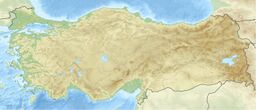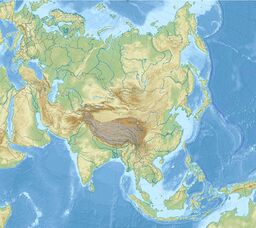Unsolved:Mount Judi
| Mount Judi | |
|---|---|
 The mountain range, as seen from Şırnak in eastern Turkey | |
| Highest point | |
| Elevation | 2,089 m (6,854 ft) |
| Coordinates | [ ⚑ ] : 37°22′10″N 42°20′39″E / 37.36944°N 42.34417°E |
| Geography | |
| Location | Şırnak, Turkey |
| Parent range | Armenian / Taurus / Zagros Mountains |
Mount Judi (Turkish: Cudi Dağı; Arabic: ٱلْجُودِيّ;[1] Armenian: Ջուդի լեռը; Kurdish: Çiyayê Cûdî) is Noah's apobaterion or "Place of Descent", the location where the Ark came to rest after the Great Flood, according to very early Christian and Islamic tradition (based on the Quran, 11:44).[1] The Quranic tradition is similar to the Judeo-Christian legend. The identification of Mount Judi as the landing site of the ark persisted in Syriac and Armenian tradition throughout Late Antiquity, but was abandoned for the tradition equating the biblical location with the highest mountain in Turkey, that is Mount Ararat.
Etymology and geography
The mountainous area that Mount Judi is part of, was known as Qardū (Syriac: ܩܪܕܘ) in Syriac texts, Gordyene by Greek and Roman writers, and Kordukh in Armenian.[3]
Syriac, Islamic, and early Christian traditions identify Mount Judi or Qardu as a peak near or northeast of the town of Jazirat ibn 'Umar (modern Cizre in south-east Turkey), at the headwaters of the Tigris River, near the modern border with Syria, and that of Iraq. Arab historian Al-Masudi[4] (d. 956), reported that the spot where the ark came to rest could be seen in his time, and that it was located at 80 parasangs (approximately 32 mi (51 km)) from the Tigris. The mountain was historically located in the province of Corduene, south of Lake Van.
The Arabic word al-Jūdiyy (ٱلْجُودِيّ), originates from the Syriac word Gudo (ܓܘܕܐ) meaning "Mounds" or "Elevations".[5] The relation of some of the spellings is clear. The origin of Judi is less clear. It is usually interpreted as a corrupted version of the same name, via Al-Gurdi (Reynolds 2004). The proposal that the two names are ultimately the same was first advanced by the English Orientalist George Sale in his translation of the Qur'an published in 1734. Sale's footnote reads:[2]
This mountain [al-Judi] is one of those that divide Armenia on the south, from Mesopotamia, and that part of Assyria which is inhabited by the Kurds, from whom the mountains took the name Cardu, or Gardu, by the Greeks turned into Gordyae, and other names. ... Mount Al-Judi (which seems to be a corruption, though it be constantly so written by the Arabs, for Jordi, or Giordi) is also called Thamanin (Geogr. Nub. p. 202), probably from a town at the foot of it.—George Sale, 1734; p. 214-215
Sale goes on to say that there was once a famous Christian monastery on the mountain,[2] but that this was destroyed by lightning in the year 776 A.D., following which:
the credit of this tradition hath declined, and given place to another, which obtains at present, and according to which the ark rested on Mount Masis, in Armenia, called by the Turks Agri Dagi.—Sale, 1734; p. 214-215
The Arabic name of the mountain, Judi, has also been proposed to be a corruption of the Syriac ܩܪܕܘ Qardō written in Arabic with the Arabic letters waw (و) and raa (ر) being confused in early Islamic manuscripts due to their early resemblance, and then making its way into the Qur’an and Islamic tradition. This is supported by the fact that only in the Syriac Bible is the mountain which Noah's ark rested on called Qardō, as opposed to Ararat in other Bibles.[6]
A number of sources (including Islamic and Christian) speak of there being at least two settlements near the mountain, one being the ancient ruins of Thamanin (located to the south of the mountain),[7] and the other being the city of Nesbin (near the border with Syria), from where people had come to visit the ark.[2] Thamanin (meaning "Eighty" in Arabic) is thought to have been founded by Noah and the survivors of the flood, who were thought to number around 80, and a tel that was thought to be the ruin of Thamanin is located east of Cizre[7] (one of the places that is thought to have the tomb of Noah).[8]
A Chaldean Archbishop of Babylon, that is Prince Nouri, had travelled from Kochanis in Turkey to Urmiah in Persia. In Urmiah, he met with Dr. Frederick B. Coan, and told him that during the journey, after making three attempts to find the ark, he went to it on the 25th of April, 1887. Accounts collected by Dr. Lee Spencer and Dr. Jean Luc Lienard of the Southwestern Adventist University in the United States , regarding a number of those who claimed to have seen the ark, point to the ark being in south-eastern Turkey, in a mountainous region with swamps, lakes and oil fields, south of Lake Van and west of Lake Urmia.[2]
Religious traditions
Christianity
The Assyrians of the eastern part of the Tigris River had a legend of the ark resting on the Djûdi mountain in the land of Kard. This legend may in origin have been independent of the Genesis' account of Noah's flood, rooted in the more general Near Eastern flood legends, but following Christianization of the Syrians, from about the second century A.D., it became associated with the Mountains of Ararat, where Noah landed according to Genesis, and from Syria also, this legend also spread to the Armenians. The Armenians did not traditionally associate Noah's landing site with Mount Ararat, known natively as Masis, and continued to associate Noah's ark with Mount Judi, until the 11th century.[9]
The biblical Ararat is thought be a variation of Urartu, an ancient term for the region north of ancient Assyria, which encompasses the Armenian plateau. According to Josephus, the Armenians in the first century showed the remains of Noah's ark at a place called αποβατηριον "Place of Descent" (Armenian: Նախիջեւան, Nakhichevan, Ptolemy's Ναξουανα), about 60 miles (97 km) southeast of the summit of Mount Ararat (c. [ ⚑ ] 39°04′N 45°05′E / 39.07°N 45.08°E).[10] The "mountains of Ararat" in Genesis have become identified in later (medieval) Christian tradition with the peak now known as "Mount Ararat" itself, a volcanic massif in Turkey and known in Turkish as "Agri Dagh" (Ağrı Dağı).
Islam
According to the Qur'an (11:44),[1] the final resting place of the vessel was called "Judi", without the word "mountain".
Then the word went forth: "O earth! swallow up thy water, and O sky! Withhold (thy rain)!" and the water abated, and the matter was ended. The Ark rested on Al-Judi, and the word went forth: "Away with those who do wrong!—Quran, 11:44[1]
The ninth century Persian geographer Ibn Khordadbeh identified the location of mount Judi as being in the land of Kurds (Al-Akrad), and the Abbasid historian Al-Mas'udi (c. 896–956) recorded that the spot where it came to rest could be seen in his time. Al-Mas'udi also said that the Ark began its voyage at Kufa in central Iraq, and sailed to Mecca, where it circled the Kaaba, before finally travelling to Judi. Yaqut al-Hamawi, also known as Al-Rumi, placed the mountain "above Jazirat ibn Umar, to the east of the Tigris," and mentioned a mosque built by Noah that could be seen in his day, and the traveller Ibn Battuta passed by the mountain in the 14th century.[4]
See also
- İlandağ of the Lesser Caucasus in Nakhchivan, Azerbaijan
- List of volcanoes in Turkey
- List of mountains in Turkey
- Mount Cilo
- Mount Uludoruk
- Searches for Noah's Ark
- The Sinjar Mountains in Nineveh Governorate, Iraq
References
- ↑ 1.0 1.1 1.2 1.3 Quran 11:44 (Translated by Yusuf Ali)
- ↑ 2.0 2.1 2.2 2.3 2.4 Spencer, Lee; Lienard, Jean Luc (2009). "The Search For Noah's Ark". Southwestern Adventist University. https://origins.swau.edu/papers/global/noah/eng/index.html.
- ↑ McAuliffe, Jane Dammen (2001). Encyclopaedia Of The Quran. 1. Brill. pp. 146–147. ISBN 978-90-04-11465-4. https://referenceworks.brillonline.com/entries/encyclopaedia-of-the-quran/judi-EQSIM_00245?s.num=0&s.f.s2_parent=s.f.book.encyclopaedia-of-the-quran. Retrieved 11 January 2023.
- ↑ 4.0 4.1 Lewis, J. P. (December 1984), Noah and the Flood: In Jewish, Christian, and Muslim Tradition, The Biblical Archaeologist, p. 237(Subscription content?)
- ↑ Sawma, Gabriel (2006) (in en). The Qur'an, Misinterpreted, Mistranslated, and Misread: The Aramaic Language of the Qur'an. Gabriel Sawma. ISBN 978-0-9778606-9-2. https://books.google.com/books?id=WBx2ejzo_v0C&dq=gudo+syriac&pg=PA293.
- ↑ Mingana, Alphonse (2004). Syriac Influence on the Style of the Kur'an. pp. 97.
- ↑ 7.0 7.1 Compton, S. C. (2021). Locating The City Of Thamanin (Thamanin Şehrının Konumu). Academia. pp. 1–13. https://www.academia.edu/49451609. Retrieved 2021-07-15.
- ↑ "Tomb of Noah". https://madainproject.com/tomb_of_noah.
- ↑ Conybeare, F. C. (April 1901) (in de). Review of Friedrich Murat, Ararat und Masis, Studien zur armenischen Altertumskunde und Litteratur. 5. Heidelberg, Germany: The American Journal of Theology, The University of Chicago Press. pp. 335–337. https://www.jstor.org/stable/3152410.
- ↑ Conybeare (1901)
External links
- Mt. Cudi on NoahsArkSearch.Com
- Research concerning Mount Judi including some English articles
- Ark search
- Discovering the Lost City of Thamanin
- Bill Crouse: "Noah's ark's final berth is Cudi"
 |








